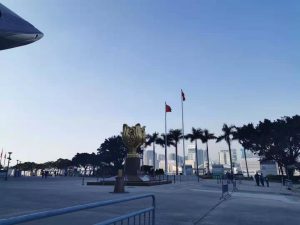
Fig. 1: Protagonists are looking at the modern Hong Kong Island landscape from a distance. Scenes from Little Cheung, 1999, directed by Fruit Chan.
Little Cheung was released in 1999, telling a story of a streetwise 9-year-old boy. The story happened in 1997, the year when Hong Kong was returned to China. Political metaphor is one of the most important aspects in the movie. The geographical location, architecture and character all represent different meanings. For example, Hong Kong Convention and Exhibition Centre (HKCEC), which was completed in 1997, signifies the end of British colonial rule, and the reunification with China. The new wing of HKCEC featured with bird-like rooftop and glass curtain overlooking the Victoria Harbour on three sides. The site where the large-scale architecture located served as the 1997 Hong Kong Handover Ceremony, giving it a strong political meaning.
Fruit Chan made HKCEC constantly exist in every frame of the movie when the protagonists standing at Tsim Sha Tsui (TST). The image of HKCEC is positioned stably at the left part of the frame, becoming a trope of China’s governing in the near future that yet to come. Countless skyscrapers stand beside HKCEC. Victoria Harbour lies in the middle of the frame, separating the protagonists and HKCEC in Hong Kong Island (HKI). Protagonists are looking at the modern landscape from a distance. (Fig. 1)
In the reality, the landscape of HKI viewing from TST does not change a lot (Fig. 2), yet, TST has redeveloped into a large public space for visitors nowadays (Fig. 3). Fruit Chan didn’t modify the landscape when presenting the images, which indicates his realism style in filming. However, when walking at the Golden Bauhinia Square and seeing the building with the Sculpture of Forever Blooming Bauhinia, national flag of the PRC and The Monument in Commemoration of the Return of Hong Kong to China stand by, a far more complicated feeling flows into my heart (Fig. 4 & Fig. 5). Contrasted with the view far away in TST, the large-scale building gives me a sense of futility and threatening. Its metaphor of power, supervision and ownership is enlarged by its form, making me lost myself as a small-scaled human-being.


Fig. 2 (left): the landscape of HKI viewing from TST, with HKCEC seen. Photographed by Li Yueshan. Fig. 3 (Right): TST has redeveloped into a large public space for visitors. Photographed by Li Yueshan


Fig. 4 & 5: walking at the Golden Bauhinia Square and staring at the HKCEC (I didn’t take photos right in front of the building since I feel a powerful order under the large-scale architecture, making me uncomfortable to record the image into my camera). Photographed by Li Yueshan.
HKI was the first part ceded by the Qing Empire to the British Government. Numerous classical and Edward period architectures are concentrated in the Central, representing its colonial history. However, standing at the protagonist’s position, only the modern skyscrapers with the distinctive HKCEC are seen. The colonial history has disappeared in HK local resident’s eyes, instead, modernity (HK as Financial Centre) reappeared. Additionally, those modernism glassed architectures in HKI contrasts the falter Tong Lau in Kowloon, emphasising the mismatch of the poor and the elites, the old and new. Besides, HKCEC symbolizes the new period of HK after 1997, meaning that a powerful regulator will steadily exist at the left in the future.
All the history and metaphor of HKI are far from the protagonist, with Victoria Harbour lies between. This signifies that the grand narrative of the British colony, economic development and China reunification is detached from local people’s everyday life. HKI becomes the most typical image under the gaze, reflecting the world’s desire to HK. Under such an anamorphic image, local citizens and the real culture are hidden (in Kowloon). Interestingly, protagonists (local residents) also talk about the buildings in HKI, however, as an outsider.
Fruit Chan’s camera is shooting from TST, from the local citizen’s perspective, demonstrating his insistent focus on ordinary people. He sharply points out that the grand narrative to residents is an illusion far away, separated by the Victoria Harbour. After 1997, people still live seem to be as usual in Kowloon – ironically, TST had redeveloped to a commercial area for visitors and elites now, completely failed to represent HK local culture and ordinary people in the film.
Li Yueshan 3035663760
Appreciate that you weaved in the colonial and historical context of the film and Hong Kong Island in your report. The scene when Little Cheung, Fan, and her sister was at the waterfront is certainly a crucial scene of the movie that depicts the air of uncertainty around Hong Kong’s autonomy after the 1997 handover. The brief reference on Abbas’ cultural of disappearance could have been elaborated as you noted the ever-changing identity of Hong Kong along with its architecture. The insight of having HKCEC as an anchor of the scene and why Fruit Chan is shooting Hong Kong Island’s skyline from TST is particularly thoughtful. It would also benefit more if you can describe a bit more of the movie scene that your fieldwork is based on and compare the photos you have taken with some movie stills.